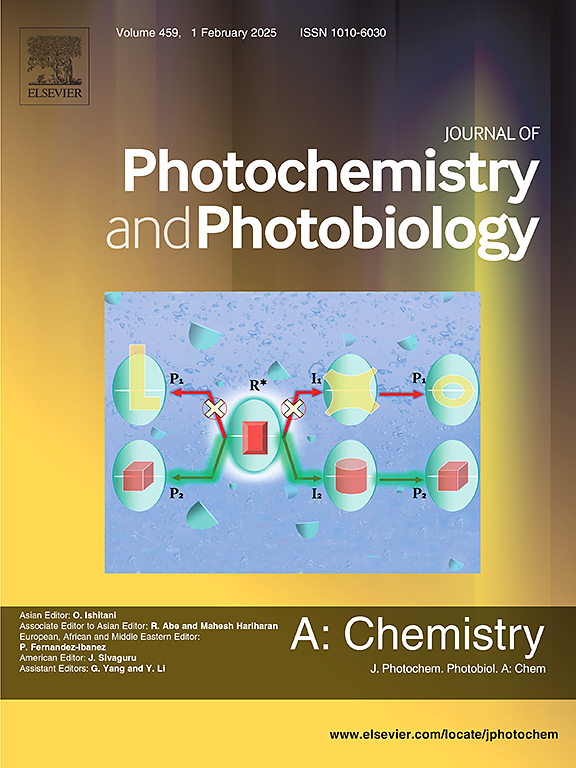照明RPMI-1640:荧光动力学和光学见解的生物应用
IF 4.7
3区 化学
Q2 CHEMISTRY, PHYSICAL
Journal of Photochemistry and Photobiology A-chemistry
Pub Date : 2025-06-02
DOI:10.1016/j.jphotochem.2025.116537
引用次数: 0
摘要
RPMI-1640是一种常用的细胞培养基,在生物学研究和临床研究中具有多种用途。鉴于苯酚红是RPMI-1640的重要组成部分,在基于荧光的分析中评估介质的光学特性对于促进生物学研究中的精确数据解释至关重要。本研究通过激光诱导荧光(LIF)光谱和差分光谱分析(DSA)对RPMI-1640在可见光谱范围内的荧光特性进行了研究。吸收光谱表明在可见区域分布广泛,这可以归因于维生素B12、酚红和核黄素等成分;然而,当波长在400 ~ 450 nm范围内激发时,观察到明显的荧光发射。用405 nm激光测量的荧光稳定性在30分钟内显示出最小的信号退化。此外,角度依赖的荧光特性和在差异光谱中观察到的不对称性为空间非均匀内滤效应(2 - ife)提供了证据,其中发射荧光的重吸收改变了强度和光谱剖面。DSA进一步阐明了第2 - ife,确定了荧光在很大程度上不受内部滤光器效应影响的等吸样点,从而使它们适用于培养基中细胞特性的光学评估。本文章由计算机程序翻译,如有差异,请以英文原文为准。

Illuminating RPMI-1640: Fluorescence dynamics and optical insights for biological applications
RPMI-1640 is a commonly utilized cell culture medium that serves a variety of purposes in both biological research and clinical investigations. Given that Phenol Red constitutes a significant part of RPMI-1640, it is crucial to evaluate the medium’s optical characteristics in fluorescence-based assays to facilitate precise data interpretation in biological studies. This research examines the fluorescence properties of RPMI-1640 within the visible spectral range through the application of laser-induced fluorescence (LIF) spectroscopy and differential spectral analysis (DSA). The absorption spectrum indicates a broad distribution across the visible region, which can be attributed to constituents such as Vitamin B12, Phenol Red, and Riboflavin; however, notable fluorescence emission was observed when excited by wavelengths ranging from 400 to 450 nm. The stability of fluorescence, as measured with a 405 nm laser, exhibited minimal signal degradation over a 30-minute period. Additionally, the angular-dependent fluorescence characteristics and the asymmetries observed in the difference spectra provided evidence for the spatially non-homogeneous inner filter effect (2nd-IFE), wherein the reabsorption of emitted fluorescence modifies both the intensity and spectral profile. DSA further elucidated the 2nd-IFE, identifying isosbestic-like points where fluorescence remains largely unaffected by inner filter effects, thus rendering them appropriate for optical assessments of cellular properties within the culture medium.
求助全文
通过发布文献求助,成功后即可免费获取论文全文。
去求助
来源期刊
CiteScore
7.90
自引率
7.00%
发文量
580
审稿时长
48 days
期刊介绍:
JPPA publishes the results of fundamental studies on all aspects of chemical phenomena induced by interactions between light and molecules/matter of all kinds.
All systems capable of being described at the molecular or integrated multimolecular level are appropriate for the journal. This includes all molecular chemical species as well as biomolecular, supramolecular, polymer and other macromolecular systems, as well as solid state photochemistry. In addition, the journal publishes studies of semiconductor and other photoactive organic and inorganic materials, photocatalysis (organic, inorganic, supramolecular and superconductor).
The scope includes condensed and gas phase photochemistry, as well as synchrotron radiation chemistry. A broad range of processes and techniques in photochemistry are covered such as light induced energy, electron and proton transfer; nonlinear photochemical behavior; mechanistic investigation of photochemical reactions and identification of the products of photochemical reactions; quantum yield determinations and measurements of rate constants for primary and secondary photochemical processes; steady-state and time-resolved emission, ultrafast spectroscopic methods, single molecule spectroscopy, time resolved X-ray diffraction, luminescence microscopy, and scattering spectroscopy applied to photochemistry. Papers in emerging and applied areas such as luminescent sensors, electroluminescence, solar energy conversion, atmospheric photochemistry, environmental remediation, and related photocatalytic chemistry are also welcome.

 求助内容:
求助内容: 应助结果提醒方式:
应助结果提醒方式:


